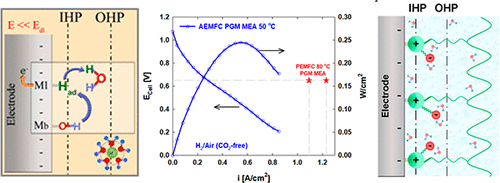当前位置:
X-MOL 学术
›
Chem. Rev.
›
论文详情
Our official English website, www.x-mol.net, welcomes your
feedback! (Note: you will need to create a separate account there.)
Alkaline Anion-Exchange Membrane Fuel Cells: Challenges in Electrocatalysis and Interfacial Charge Transfer.
Chemical Reviews ( IF 51.4 ) Pub Date : 2019-11-08 , DOI: 10.1021/acs.chemrev.9b00157 Nagappan Ramaswamy 1 , Sanjeev Mukerjee 1
Chemical Reviews ( IF 51.4 ) Pub Date : 2019-11-08 , DOI: 10.1021/acs.chemrev.9b00157 Nagappan Ramaswamy 1 , Sanjeev Mukerjee 1
Affiliation

|
Alkaline anion-exchange membrane (AAEM) fuel cells have attracted significant interest in the past decade, thanks to the recent developments in hydroxide-anion conductive membranes. In this article, we compare the performance of current state of the art AAEM fuel cells to proton-exchange membrane (PEM) fuel cells and elucidate the sources of various overpotentials. While the continued development of highly conductive and thermally stable anion-exchange membranes is unambiguously a principal requirement, we attempt to put the focus on the challenges in electrocatalysis and interfacial charge transfer at an alkaline electrode/electrolyte interface. Specifically, a critical analysis presented here details the (i) fundamental causes for higher overpotential in hydrogen oxidation reaction, (ii) mechanistic aspects of oxygen reduction reaction, (iii) carbonate anion poisoning, (iv) unique challenges arising from the specific adsorption of alkaline ionomer cation-exchange head groups on electrocatalysts surfaces, and (v) the potential of alternative small molecule fuel oxidation. This review and analysis encompasses both the precious and nonprecious group metal based electrocatalysts from the perspective of various interfacial charge-transfer phenomena and reaction mechanisms. Finally, a research roadmap for further improvement in AAEM fuel cell performance is delineated here within the purview of electrocatalysis and interfacial charge transfer.
中文翻译:

碱性阴离子交换膜燃料电池:电催化和界面电荷转移的挑战。
在过去的十年中,由于氢氧根阴离子导电膜的最新发展,碱性阴离子交换膜(AAEM)燃料电池引起了人们的极大兴趣。在本文中,我们将当前最先进的AAEM燃料电池与质子交换膜(PEM)燃料电池的性能进行了比较,并阐明了各种超电势的来源。尽管持续发展高导电性和热稳定性阴离子交换膜无疑是一个主要要求,但我们试图将重点放在碱性电极/电解质界面的电催化和界面电荷转移方面。具体而言,此处提供的一项关键分析详细介绍了(i)氢氧化反应中超电势较高的根本原因,(ii)氧还原反应的机理,(iii)碳酸根阴离子中毒,(iv)碱性离聚物阳离子交换头基在电催化剂表面上的特异性吸附所带来的独特挑战,以及(v)替代性小分子燃料氧化的潜力。从各种界面电荷转移现象和反应机理的角度出发,本综述和分析涵盖了贵金属和非贵金属族的电催化剂。最后,在电催化和界面电荷转移的范围内,画出了进一步改善AAEM燃料电池性能的研究路线图。从各种界面电荷转移现象和反应机理的角度出发,本综述和分析涵盖了贵金属和非贵金属族的电催化剂。最后,在电催化和界面电荷转移的范围内,画出了进一步改善AAEM燃料电池性能的研究路线图。从各种界面电荷转移现象和反应机理的角度出发,本综述和分析涵盖了贵金属和非贵金属族的电催化剂。最后,在电催化和界面电荷转移的范围内,画出了进一步改善AAEM燃料电池性能的研究路线图。
更新日期:2019-11-11
中文翻译:

碱性阴离子交换膜燃料电池:电催化和界面电荷转移的挑战。
在过去的十年中,由于氢氧根阴离子导电膜的最新发展,碱性阴离子交换膜(AAEM)燃料电池引起了人们的极大兴趣。在本文中,我们将当前最先进的AAEM燃料电池与质子交换膜(PEM)燃料电池的性能进行了比较,并阐明了各种超电势的来源。尽管持续发展高导电性和热稳定性阴离子交换膜无疑是一个主要要求,但我们试图将重点放在碱性电极/电解质界面的电催化和界面电荷转移方面。具体而言,此处提供的一项关键分析详细介绍了(i)氢氧化反应中超电势较高的根本原因,(ii)氧还原反应的机理,(iii)碳酸根阴离子中毒,(iv)碱性离聚物阳离子交换头基在电催化剂表面上的特异性吸附所带来的独特挑战,以及(v)替代性小分子燃料氧化的潜力。从各种界面电荷转移现象和反应机理的角度出发,本综述和分析涵盖了贵金属和非贵金属族的电催化剂。最后,在电催化和界面电荷转移的范围内,画出了进一步改善AAEM燃料电池性能的研究路线图。从各种界面电荷转移现象和反应机理的角度出发,本综述和分析涵盖了贵金属和非贵金属族的电催化剂。最后,在电催化和界面电荷转移的范围内,画出了进一步改善AAEM燃料电池性能的研究路线图。从各种界面电荷转移现象和反应机理的角度出发,本综述和分析涵盖了贵金属和非贵金属族的电催化剂。最后,在电催化和界面电荷转移的范围内,画出了进一步改善AAEM燃料电池性能的研究路线图。











































 京公网安备 11010802027423号
京公网安备 11010802027423号